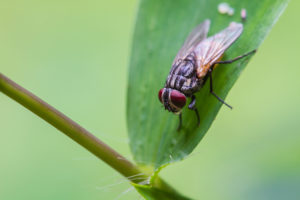 The common name reflects this species’ habit of forming compact clusters of hibernating individuals, typically in wall voids or attics. It is widely distributed in Europe, Canada, and throughout the United States except for those states bordering the Gulf of Mexico. Specifically, cluster flies occur wherever their host earthworm occurs, which is usually in a well-drained silt-loam soil with grass cover.
The common name reflects this species’ habit of forming compact clusters of hibernating individuals, typically in wall voids or attics. It is widely distributed in Europe, Canada, and throughout the United States except for those states bordering the Gulf of Mexico. Specifically, cluster flies occur wherever their host earthworm occurs, which is usually in a well-drained silt-loam soil with grass cover.
Adults are about 3/8″ (8 mm) long, robust. Color dark gray, non-metallic in color.
Adults overwinter in sheltered places, emerging in the spring to mate. Eggs are laid in soil cracks and hatch in about 3 days. The larvae are parasitoid upon the earthworm host, entering at almost any point along the body wall. Developmental time (egg to adult) varies from 27-39 days. There are usually 4 generations per year.
As days shorten and the weather cools, cluster flies often enter structures to overwinter, sometimes traveling more than a mile to do so. They usually occupy attics and/or the between-wall voids of walls which receive the most sunlight, usually the south and possibly the east or west walls. Typically, they use the same structure year after year. They do not multiply within structures. They can be a problem or nuisance in the autumn, winter, and/or spring; autumn when they enter to hibernate; on warm, sunny winter days; and again, in the spring when they attempt to leave the structure. Actually, they can be stimulated by warmth to resume activity almost anytime. Sometimes it takes no more than the furnace to be turned on and thoroughly warm the inside of the-structure to start activity, but it usually additionally requires a bright sunny day to warm the walls from the outside. Once stimulated, cluster flies seek light. Therefore, they usually come out around loose-fitting wall switches and outlets, ceiling fixtures, window and door frames, window pulleys, etc. Cluster flies can usually be found at windows crawling on the panes or frames, or around lamps or lights. They are sluggish in their movements in comparison to house flies. They give off a buckwheat honey odor and leave a greasy spot when crushed.
No attempt should be made to kill these insects in wall voids at any time because the bodies of dead insects attract dermestid beetles (larder beetles, carpet beetles, etc.). Dermestid larvae wander and will readily enter the living space, causing numerous complaints. Instead, wait until summer when all live over-wintering adults are out of the wall voids. Then follow the outside control given below. However, temporary relief is possible by using a vacuum and/or space sprays, and sealing interior entrances. Control begins outside. Reducing the outside population is impractical for cluster flies since their larvae breed in earthworms. Therefore, use of preventative physical and chemical barriers aimed at adults before they congregate and attempt to enter buildings is recommended. Physical barriers involve exclusion.
Although total exclusion is probably not possible, all vents (roof, overhang, weepholes, etc.) should be screened with at least 16-mesh screening. Caulk around cable entrances, windows, doors, and overhangs. These steps should be taken in June or July. Preventative chemical barriers involve applying a highly repellent, long-lasting residual to all outside vertical walls and the adjacent overhang; microencapsulated pyrethroids or pyrethrins, or pyrethroid wettable powder formulations work best. This application is made just before the last seasonal generation of adults emerge; if in doubt, check with your cooperative extension agent. The timing of this treatment is crucial to its effectiveness. One application is required; in New York, the recommended treatment period is between 15-30 August. If application is made earlier, pests may enter before frost and if made later, then pests may enter before application.
